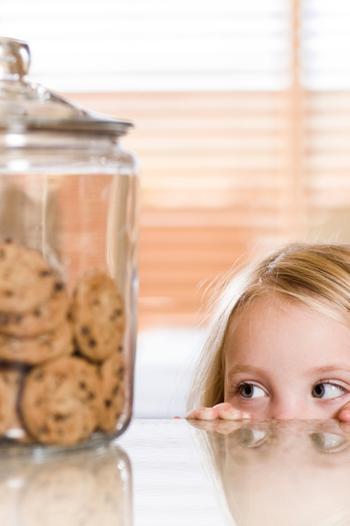How many do you think are in there?
Duration/age

Is it full, is it empty, is it nearly to the top, can you squish one more in before it pops?
When you are unpacking and putting away the shopping with your child, talk about the capacity or volume of the jars you have bought. Which jar is bigger and holds more? Are all of the jars full to the top or could some of the jars hold more? How do you know what size the jar is? Sometimes a jar or container can look bigger than another, but is it? How do you know?
Once all of the jars have been unpacked, talk about your own storage containers.
Our biscuit jar already has biscuits in it. How many biscuits do you think you can fit in? How many are already in the jar? Can you work that out without counting?
Experiment with different food items. Can you fit more pasta into the jar than rice? Can you fit more pasta shapes in when they are short and squiggly, instead of long and thin? Is there a difference between liquids and solids? When you pour liquid into a jar can you see any spaces left? Or does it go right to the edges of the jar?
You can also try to predict how many things are in each of the jars and containers. How many biscuits? How many artichokes? Is it easier to predict when the objects are bigger and there is more space around each item? Or when they are small and tightly packed together?
Materials you will need
- Jars
- See-through containers
- Shopping
Skills this activity improves
Why does this matter?
As children notice the quantities on containers they are learning about measurement and number and the different ways we can compare size. Size can be compared using volume, capacity, mass, time and temperature.
By filling containers or estimating how much a container can hold they are exploring the different language and tools we use to compare and measure. If an object is solid, such as a biscuit, you could use number and counting to talk about how many are in the container, compared to how you talk about a packet of rice. When we talk about objects that are small and have little space between each we do not use number or counting as a strategy, instead we would talk about weight or the number of packets.
What does this lead to?
Exploring the different ways we can measure objects encourages children to problem-solve and to notice similarities and differences. When children can identify what is the same about an object they begin to generalise solutions and strategies from one event to another. This is the beginning of problem-solving.
Language to use
- Full, empty
- Half, quarter, a third
- Top, bottom, middle, side, underneath, against
- How many, how much
- More, less, some, add, remove
- First, next, last, finished
Questions to use
- How many more can we add?
- Will any more fit?
- Which jar has more in it?
- Which jar can hold more?
- Which container will this fit in?
- Which container is bigger?
- What needs to go in first?
- Is the jar empty or full?
Useful tips
- You might also like to take a look at the activities Packing your bag and Packing the lunchbox.
- Remember to talk to your child in your home language.
More ideas
- Go for a walk around the yard, local neighbourhood or park to collect different objects for creating your own estimating jars.
- When shopping point out the different sized containers. Try and predict which one holds more.
Variation by age
Birth to two year olds
- Borrow stacking toys from the local toy library.
- Set up a water play trough with different sized containers for filling and emptying.
- Thread large objects onto a string or shoelace. Try and predict how many the string will hold.
Three to five year olds
- Read the story of “The Doorbell rang” - you can borrow it from the local library.
- Collect jars of different shapes and sizes for filling and emptying.
- Set up a weigh station using the kitchen or bathroom scales. Weigh different items to see which is heavier.
Questions to ask
- Where is the top? Where is the bottom?
- Can you fit more in?
- How many is that?
Questions to ask
- How many will you need?
- Could you fit more in if you packed it differently?
- Which way will you need to put that in?
Language to use
- More, empty, full, nearly
- Top, bottom, middle, half
- First, next, last
Language to use
- Estimate, predict, guess
- Measure, weigh, balance
- Full, empty,
- Half, quarter, a third
- Top, bottom, middle, side, underneath, against
- How many, how much
- More, less, some, add, remove
- First, next, last, finished


